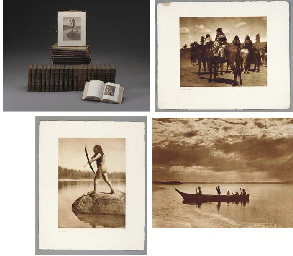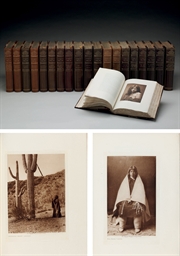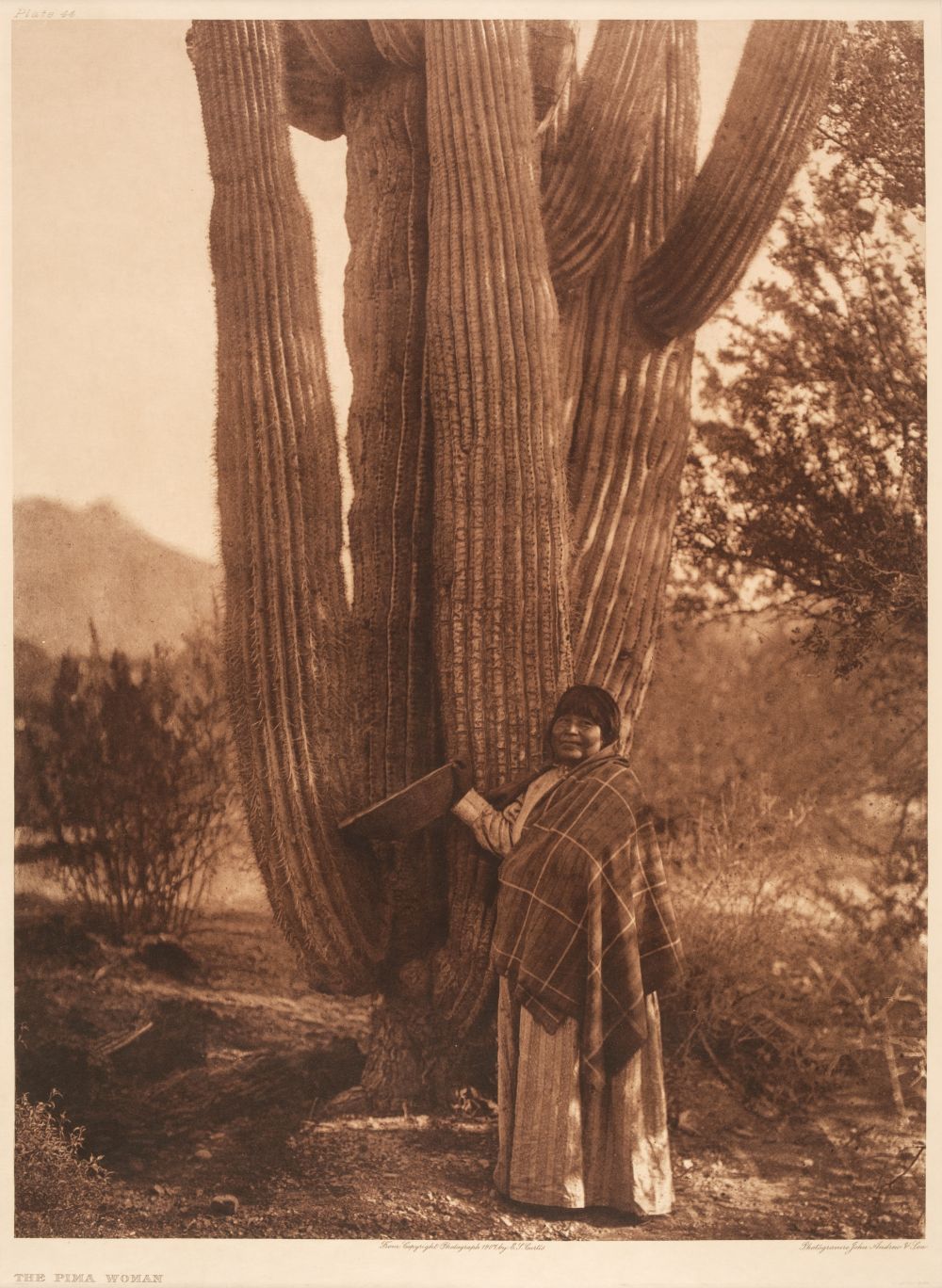CURTIS, Edward Sheriff (1868-1952). The North American Indian being a Series of Volumes Picturing and Describing the Indians of the United States and Alaska. Edited by Frederick Webb Hodge. Foreword by Theodore Roosevelt. Field Research conducted under the patronage of J. Pierpont Morgan . [Cambridge, Mass.], 1907-1930. Together 40 volumes: text in 20 volumes, 4 o (313 x 239 mm); Supplementary Large Plates in 20 portfolios, large folio (582 x 239 mm). COMPLETE: Text volumes : 1,511 illustrations, comprising 1,505 photogravures, 32 of them colored, the rest in sepia, 4 maps and 2 diagrams. Portfolios : 723 photogravures in sepia (numbered 1-722 with two plates numbered 400); letterpress index leaves in each portfolio. Original publisher's brown half morocco gilt, text volumes with top edges gilt, others uncut, by H. Blackwell (some light scuffing and wear, first nine text volumes with some dampstaining to covers, with cloth partly pulled on the first two, color of vol. XIII less uniform; portfolios lacking some silk ties, no. 12 with cover detached). LIMITED EDITION, number 45 of 500 proposed sets (but probably only 272 sets produced, see below), this copy on Van Gelder paper (watermarked "Holland" or "Van Gelder Zonen"), the Foreword in vol. I SIGNED BY THEODORE ROOSEVELT, the General Introduction signed by Edward S. Curtis and dated 1907. A FINE, COMPLETE SET OF CURTIS'S MONUMENTAL WORK, The North American Indian , one of the most expensive undertakings in the history of book production and one of the most comprehensive ethnographic records of the native tribes of North America. According to author and critic A.D. Coleman, it is "an absolutely unmatched masterpiece of visual anthropology, and one of the most thorough, extensive and profound photograph works of all time" ( Sacred Legacy: Edward S. Curtis and the North American Indian , ed. Christopher Cardozo, NY, 2000, p.25). The North American Indian took 16 years longer to complete than projected, and exceeded its budget by nearly $1.4 million. Curtis's immense work contains one of the largest visual records of Native Americans in existence, produced in lavish style under the patronage of J. Pierpont Morgan. BEGINNINGS Edward Sheriff Curtis was born in White Water, Wisconsin in 1868 but his great interest in American Indians developed after his family moved to Minnesota. Here, Curtis lived near the Chippewa, Menominee, and Winnebago tribes. Through instruction manuals available at the time, the teenage Curtis built crude cameras and taught himself the rudiments of photography. In 1887, the Curtises moved to Washington Territory in order to find a more temperate climate for Curtis's ailing father. There Edward Curtis encountered many of the Native American tribes of the Pacific Northwest. The sudden death of his father left Curtis responsible for the family, and he provided for them by farming, fishing, digging clams and doing chores for neighbors. Throughout this time Curtis continued to hone his photographic skills and in 1891 purchased a share in a photographic studio for $150. This venture lasted less than a year, but Curtis soon formed a partnership with Thomas Guptill, building both a photographic and photograving studio in Seattle. His first Indian portrait was taken in 1895--a portrait of "Princess Angeline," daughter of Chief Seattle (plate 314, portfolio IX). "I paid the princess a dollar for each picture I made," Curtis recalled many years later. "This seemed to please her greatly, and she indicated that she preferred to spend her time having pictures taken to digging clams." These early portraits of Princess Angeline fueled Curtis's interest in Indians, and soon he aspired to document Native American tribes through a large-scale project. In 1898, near tragedy dovetailed into good fortune when Curtis rescued several important naturalists and ethnologists from the peak of Mount Rainier: Gifford Pinchot, the Chief of the U.S. Division of Forestry, C. Har
CURTIS, Edward Sheriff (1868-1952). The North American Indian being a Series of Volumes Picturing and Describing the Indians of the United States and Alaska. Edited by Frederick Webb Hodge. Foreword by Theodore Roosevelt. Field Research conducted under the patronage of J. Pierpont Morgan . [Cambridge, Mass.], 1907-1930. Together 40 volumes: text in 20 volumes, 4 o (313 x 239 mm); Supplementary Large Plates in 20 portfolios, large folio (582 x 239 mm). COMPLETE: Text volumes : 1,511 illustrations, comprising 1,505 photogravures, 32 of them colored, the rest in sepia, 4 maps and 2 diagrams. Portfolios : 723 photogravures in sepia (numbered 1-722 with two plates numbered 400); letterpress index leaves in each portfolio. Original publisher's brown half morocco gilt, text volumes with top edges gilt, others uncut, by H. Blackwell (some light scuffing and wear, first nine text volumes with some dampstaining to covers, with cloth partly pulled on the first two, color of vol. XIII less uniform; portfolios lacking some silk ties, no. 12 with cover detached). LIMITED EDITION, number 45 of 500 proposed sets (but probably only 272 sets produced, see below), this copy on Van Gelder paper (watermarked "Holland" or "Van Gelder Zonen"), the Foreword in vol. I SIGNED BY THEODORE ROOSEVELT, the General Introduction signed by Edward S. Curtis and dated 1907. A FINE, COMPLETE SET OF CURTIS'S MONUMENTAL WORK, The North American Indian , one of the most expensive undertakings in the history of book production and one of the most comprehensive ethnographic records of the native tribes of North America. According to author and critic A.D. Coleman, it is "an absolutely unmatched masterpiece of visual anthropology, and one of the most thorough, extensive and profound photograph works of all time" ( Sacred Legacy: Edward S. Curtis and the North American Indian , ed. Christopher Cardozo, NY, 2000, p.25). The North American Indian took 16 years longer to complete than projected, and exceeded its budget by nearly $1.4 million. Curtis's immense work contains one of the largest visual records of Native Americans in existence, produced in lavish style under the patronage of J. Pierpont Morgan. BEGINNINGS Edward Sheriff Curtis was born in White Water, Wisconsin in 1868 but his great interest in American Indians developed after his family moved to Minnesota. Here, Curtis lived near the Chippewa, Menominee, and Winnebago tribes. Through instruction manuals available at the time, the teenage Curtis built crude cameras and taught himself the rudiments of photography. In 1887, the Curtises moved to Washington Territory in order to find a more temperate climate for Curtis's ailing father. There Edward Curtis encountered many of the Native American tribes of the Pacific Northwest. The sudden death of his father left Curtis responsible for the family, and he provided for them by farming, fishing, digging clams and doing chores for neighbors. Throughout this time Curtis continued to hone his photographic skills and in 1891 purchased a share in a photographic studio for $150. This venture lasted less than a year, but Curtis soon formed a partnership with Thomas Guptill, building both a photographic and photograving studio in Seattle. His first Indian portrait was taken in 1895--a portrait of "Princess Angeline," daughter of Chief Seattle (plate 314, portfolio IX). "I paid the princess a dollar for each picture I made," Curtis recalled many years later. "This seemed to please her greatly, and she indicated that she preferred to spend her time having pictures taken to digging clams." These early portraits of Princess Angeline fueled Curtis's interest in Indians, and soon he aspired to document Native American tribes through a large-scale project. In 1898, near tragedy dovetailed into good fortune when Curtis rescued several important naturalists and ethnologists from the peak of Mount Rainier: Gifford Pinchot, the Chief of the U.S. Division of Forestry, C. Har















Testen Sie LotSearch und seine Premium-Features 7 Tage - ohne Kosten!
Lassen Sie sich automatisch über neue Objekte in kommenden Auktionen benachrichtigen.
Suchauftrag anlegen